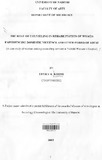| dc.contributor.author | Ngunjiri, Margaret Wanjiku | |
| dc.contributor.author | Birech, Jeniffer | |
| dc.contributor.author | Muleka, Joseph | |
| dc.date.accessioned | 2023-08-12T11:04:23Z | |
| dc.date.available | 2023-08-12T11:04:23Z | |
| dc.date.issued | 2023 | |
| dc.identifier.uri | http://erepository.uonbi.ac.ke/handle/11295/163758 | |
| dc.description | Technical Report | en_US |
| dc.description.abstract | This study focused on Women’s Economic Empowerment (WEE) in select counties in Kenya. These were Busia, Kakamega, and Kisumu in the Western region; Kajiado, Nakuru and Baringo in the Rift Valley region; Nyeri, Muranga, and Kiambu in the Central region; Nairobi region; Machakos, Kitui, and Makueni in the Eastern region; and Kwale, Mombasa and Kilifi in the Coast region. The research aimed at evaluating the contributions of the women’s movement and self-mobilization, to WEE in Kenya between 1963 and 2010, with the following specific objectives:
1. To map out a historical perspective on the contribution made by grassroots women’s groups and associations to WEE, between 1963 and 1975 which are the initial years of Kenya’s independence;
2. To examine the contribution of grassroots women’s groups and associations to WEE between 1963 – 1976, and 1976 – 1997 when the affirmative action fund started;
3. To establish the extent to which the national women’s movement influenced national policies on WEE between 1990 to date and lessons learned, including those around women’s care work, and
4. To establish what strategies work in women’s self-mobilization for WEE that can be scaled up to similar
contexts and inform policy dialogue.
The study adopted a predominantly qualitative research approach in its design of data collection, synthesis and analysis. The concept of women’s self-mobilization was measured using the Feminist Mobilization Index (FMI). The research also used the Women’s Empowerment in Agriculture Index (WEAI) which was used to assess women’s collective, instrumental and intrinsic agency. Besides, Sarah Longwe’s Women’s Empowerment model was used in combination with the WEAI to analyze various aspects of women’s empowerment that the feminist organizing efforts sought to achieve.
The overall question that the study sought to answer was: To what extent has selfmobilization by the women’s movement in Kenya resulted in Women’s Economic Empowerment?
The study used the FMI to assess the existence of the women’s movement, its dynamics and strength as well as the autonomy in the context of the political and economic environment in post-independence and subsequent spells that saw government involvement in women’s empowerment. | en_US |
| dc.description.sponsorship | Bill & Mellinda Gates Foundation | en_US |
| dc.language.iso | en | en_US |
| dc.publisher | UoN, AWSC, Women’s Economic Empowerment Hub | en_US |
| dc.rights | Attribution-NonCommercial-NoDerivs 3.0 United States | * |
| dc.rights.uri | http://creativecommons.org/licenses/by-nc-nd/3.0/us/ | * |
| dc.subject | Self-Mobilization | en_US |
| dc.subject | Women’s Movements | en_US |
| dc.subject | Economic empowerment | en_US |
| dc.subject | Women's Contributions | en_US |
| dc.subject | Kenya | en_US |
| dc.title | Assessing the Contributions of the Women’s Movements & Women’s Self-Mobilization, to Women’s Economic Empowerment in Kenya Between 1963 and 2010 | en_US |
| dc.type | Technical Report | en_US |




